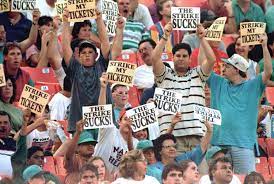On September 14, 1994, the United States experienced a significant disruption in the world of sports as Major League Baseball (MLB) players went on strike. The strike, which lasted for 232 days, marked a dark period in the history of American baseball and had far-reaching consequences for the sport and its fans. The origins of the 1994 MLB strike can be traced back to a collective bargaining dispute between the players' union, the Major League Baseball Players Association (MLBPA), and the owners. The main points of contention were revenue sharing, salary caps, and the owners' desire for cost control. Unable to reach a resolution, the players voted to go on strike on August 12, 1994. The strike had an immediate impact, as the remainder of the 1994 season was canceled, including the playoffs and World Series. This marked the first time since 1904 that the World Series was not played. The strike also carried over into the following season, resulting in the cancellation of the first 18 games of the 1995 season. The consequences of the strike were significant and far-reaching. Attendance at MLB games dropped dramatically, as fans expressed their frustration and disappointment with the players and owners. The absence of baseball left a void in the lives of fans who had come to expect the game as a staple of their summer entertainment. The strike also had financial implications for both the players and the owners. Players lost millions of dollars in salary during the strike, while owners suffered significant financial losses due to the cancellation of games and the decline in fan interest. The reputation of baseball as "America's pastime" was tarnished, and the sport struggled to regain its popularity and standing. One of the most significant long-term consequences of the strike was the erosion of fan trust and loyalty. The strike highlighted the growing disconnect between players and fans, as the high salaries of players and the perceived greed of owners became focal points of public criticism. The strike served as a wake-up call for the sport, forcing it to confront the challenges it faced and work towards rebuilding trust with its fanbase. The strike also had a lasting impact on the labor relations within professional sports. It set a precedent for future labor disputes, as players and owners became more entrenched in their positions and willing to take drastic measures to protect their interests. Subsequent labor negotiations in various sports would be shaped by the lessons learned from the 1994 MLB strike. However, despite the dark cloud that hung over baseball during this period, the sport eventually rebounded. In 1995, the MLB and the MLBPA reached an agreement, ending the strike and allowing for the resumption of the season. Baseball slowly but steadily regained its popularity, with new stars emerging and captivating fans once again. The 1994 MLB strike will forever be remembered as a significant event in the history of American sports. It served as a stark reminder of the challenges faced by professional athletes and the delicate balance between labor and management in sports. The strike changed the landscape of baseball and left a lasting impact on the sport, its players, and its fans.
14 Sept, 1994 U.S.A. Baseball Strike
